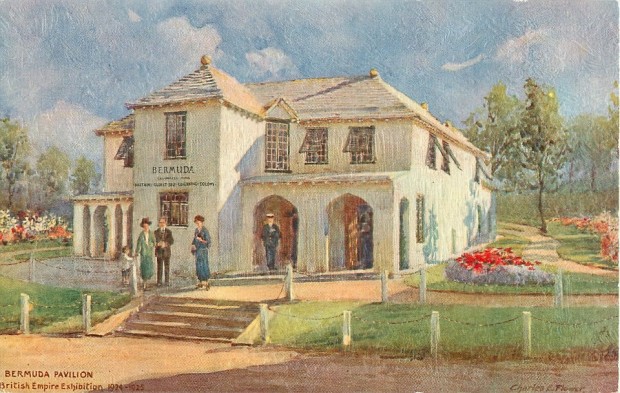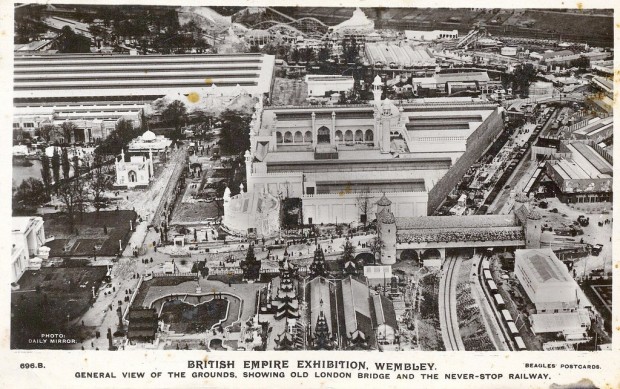Bermuda On Show At 1924 London Exhibition
The British Empire Exhibition which opened in 1924 in north London was a huge trade and travel spectacle which included such attractions as an amusement park, a stadium for mass entertainments — and a full-scale reproduction of the Bermuda house “Walsingham”, now the site of Tom Moore’s Tavern.
The idea of a great exhibition to celebrate imperial trade had been conceived as far back as 1913. In 1922, the government provided the funding for it to go ahead. The site chosen was Wembley Park in northwest London. It was criticised by some for being too far out of town, but it had good rail links: over 100 stations in the London area were within 18 minutes’ journey time. A new “motor-omnibus station” was erected, designed to deal with over 100,000 passengers a day.
“Bermuda had one of the smallest pavilions at Wembley: a reproduction of the Walsingham House — a restaurant and pub known and loved by all Bermudians,” says an official history of the British Empire Exhibition. “The original was built in 1651 and served, for a brief time, as [a haven for] the Irish poet Tom Moore. The copy was accurate in every detail, from the Bermudian slate roof to the green jalousies on the windows and even recreated Moore’s room.
Bermuda pavilion at the 1924/1925 British Empire Exhibition
“Bermuda’s history as a naval base could actually be heard in the main hall, where the bell from HMS ‘Shannon’ was rung on the hour. During one of the most famous naval battles of all time, the Shannon captured American ship “Chesapeake” outside Boston harbour during the War of 1812.
“A relief map of the island was the axis for pictures representing scenes from the island’s history, including ‘The Relief of Jamestown’ [In 1610, British ships from Bermuda brought food and supplies to starving colonists in Jamestown, Virginia]; ‘The Blockade of St. George’s Harbour’ [During the US Civil War, Confederate ships loaded with cotton tried to outrun the Union naval blockade and head towards Bermuda and, from there, to Europe] … and The US Naval Base on White’s Island [An important staging area during World War I].
“The garden surrounding the pavilion was landscaped with native flowers including Easter lillies, hibiscus, pallen and oleander.”
Built from scratch on a greenfield site, the exhibition was a showcase for goods and produce from the Empire countries.
Construction began in January 1922 and the first building to be completed was Wembley Stadium. Its first event was the 1923 Football Association Cup.
The site also included hundreds of buildings, an amusement park, ornamental lake, reservoir, outfall sewer, railway lines and roads, all built from a new, modern material — concrete. The first words transmitted over the radio by a British sovereign were spoken at the opening ceremony on 23 April 1924.
At the exhibition’s heart were 16 buildings representing 56 of the British Empire’s 58 countries at that time [only Gambia and Gibraltar did not take part].
These ranged in size from the Australian “palace” to the smaller West Indies British Guiana pavilion, which sold cocktails and displayed exhibits on sugar.
The West African building was a miniature reproduction of the walled city of Zaria in Nigeria; Ceylon was modelled on the Temple of the Tooth in Kandy; Burma reproduced in Burmese teak one of the gates of a famous pagoda at Mandalay.
Hong Kong was represented by a street of Chinese shops, and East Africa by a white walled Arab building. Inside, the countries themselves had organised displays of their goods and products. The Australian pavilion sold seven million apples. The Canadian pavilion promoted butter with a life-size refrigerated butter sculpture of the Prince of Wales in the costume of a Native American chief.
The exhibition ran for two summer seasons and attracted 27 million visitors.
Costing £12 million to stage, it was was the largest exhibition ever staged anywhere in the world up to that time.



